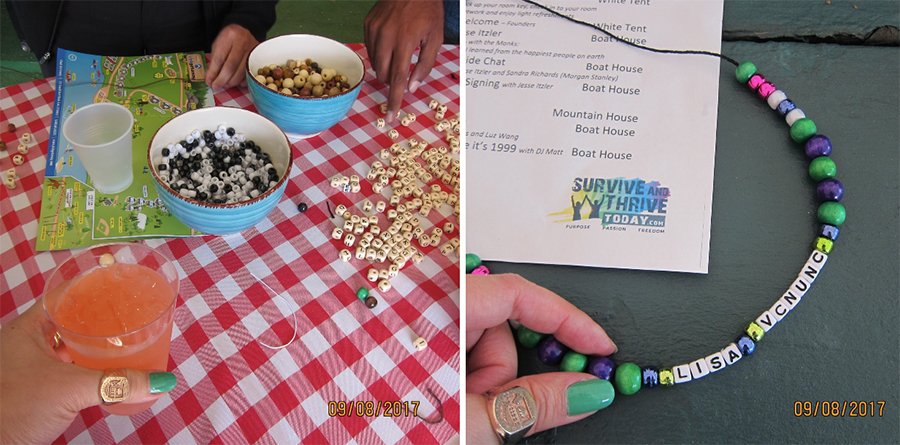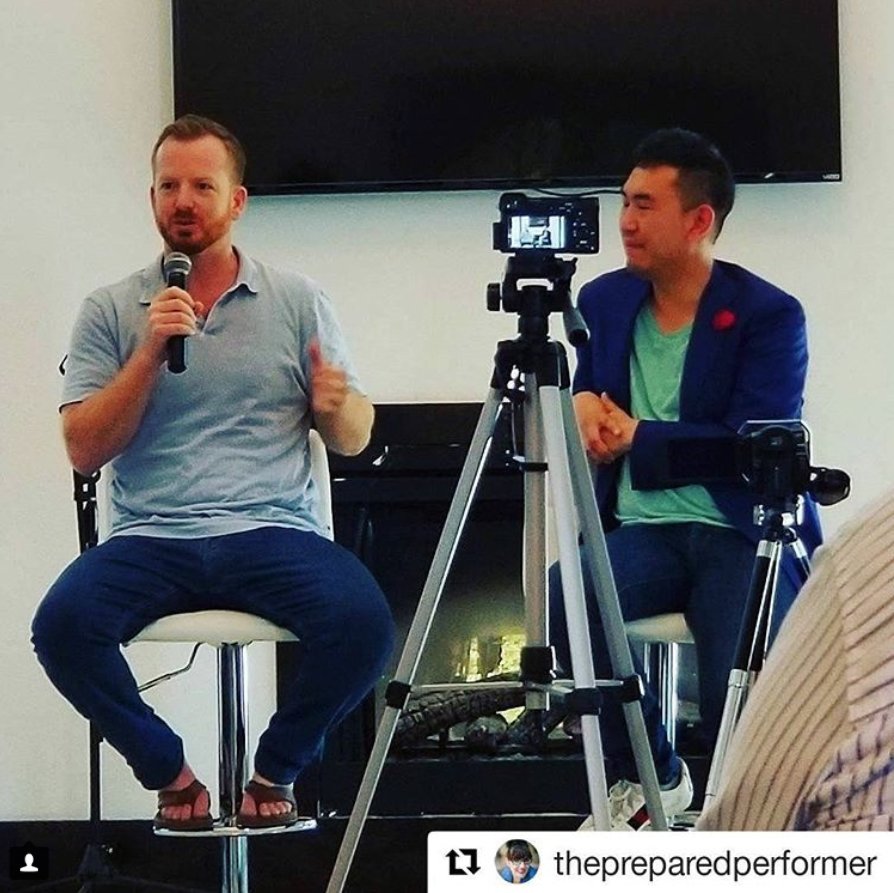“Sure! Here’s my business card, let me get yours too.”
How many times have you repeated this at a large conference as you ping pong from one person to the next, over a 2-3 day period?
Are you one of the many collecting business cards, only to have them gather dust in a big pile on the corner of your desk? You truly do intend to follow up with them, but after you follow up with the even dustier stack of cards in another corner of your desk, from the previous conference.
If you’ve attended a big conference recently and collected a ton of cards, you know exactly what I’m talking about. The challenge of big conferences is finding and having the personal experiences that lead to real connections after the event ends.
You need to consider a new approach.
I’m pleased to report that large conferences are not the only solution to accelerating your growth as a startup or for a particular niche that you want to grow in. After being invited to and speaking at multiple un-conferences recently, like the Haiti Tech Summit, China Marketing Summit, Survive and Thrive and #SMULive, I am starting to view the ritual of collecting business cards in a whole new light.
Here are 7 reasons to downgrade your conference size to upgrade the relationships you make:
Bigger is not always better
Survive and Thrive is a startup mini-conference held in Connecticut that brought entrepreneurs, investors, and mentors to a summer camp for three days. Tucked back in the hills on a private lake, I showed up at the renovated summer camp location, Club Getaway, and checked into my log cabin.
Everyone wore comfortable clothes, and there were no badges to identify who was who. Over three days, I met almost everyone at the conference, and shared lively experiences during leadership activities, meals and themed after-parties. Within this unique environment, I was able to interface with individuals from around the world in a way that created real connection — not the fleeting interactions we often experience at large conferences.
Real connection is spending more than 10 minutes with people.
Real connection is enjoying each other’s company over breakfast, lunch, and dinner.
Real connection is working in teams during fun obstacle courses.
Real connection is singing karaoke and roasting marshmallows together.
When evaluating the next conference that you invest in, don’t be fooled that bigger is better. The smaller the conference is, the better chances you have at forming real connections with other attendees and speakers.
Fun leads to funding
At Survive and Thrive (#surviveandthrive), there was an entrepreneur named Grace Lee. It was day two of the un-conference, and there was karaoke night after a “Mad Hatter” themed party. The next day, I was sitting with Grace over breakfast and an investor who was walking by stopped and said “Oh, I remember you! You were the one on the mic who sang ‘I am a Survivor’ for karaoke.”
He joined us at the table, and we reminisced about the prior night’s fun activities. The investor got to meet the entrepreneur as a real person first, instead of a high-pressure situation with limited time. I learned from Grace that she ended up getting funding from that investor who saw her singing karaoke.
It wasn’t because she went and pitched at the competition. Her karaoke performance, in combination with the entire weekend of being herself, allowed her to build a real relationship that lead to real funding. This example got repeated several times in Survive and Thrive. Investors and entrepreneurs had numerous opportunities over the three days to interact with entrepreneurs as real people, having real fun together. In Grace’s situation, having fun lead to funding.
Meeting while eating
At the Haiti Tech Summit (#haititechsummit17), another small conference I was invited to speak at, I had the opportunity to spend three days at one of the most beautiful resorts in Haiti, the Demarco. Because we were all staying at the resort, no one left for other places or activities — and more importantly — everyone ate together every meal. With a centralized area for meals, I found myself in amazing conversations with people from around the world while enjoying delicious foods.

I shared one of these meals, and a fantastic view (pictured above), with investor Milan Koch and his friend, founder of Angel Hack, Sabeen Ali. Through that conversation, they invited me to perform my 3-1-3 Method Workshop in Silicon Valley for the Global Demo Day, Haccellerator.
At large conferences with 10,000+ people, everyone eats on different schedules and in different places. We don’t realize we are missing a crucial time for connection. At the Haiti Tech Summit, I made some of the best connections meeting while eating.
Make sure that you take advantage of the facetime over food, and make an effort to sit down and get to know other attendees at your next event. No need to bring your business cards — instead, bring some questions to spark real conversations.
Flipping the pitching
Most entrepreneurs go to startup conferences to pitch their business ideas to investors. Thousands of hopeful entrepreneurs arrive at conferences, attach a nametag to their shirts, and set off on the task of searching for investors to pitch their dream to. With a less formal networking structure at Survive and Thrive, nobody wore a badge that identified them as an investor, media, speaker, or entrepreneur. Instead, one of the first group activities creating a bracelet or necklace out of beads.

That Friday night, after everyone made their own jewelry (pictured above), we took turns introducing ourselves to the group. Startups shared their ideas, but in a twist to tradition, the investors had to pitch themselves to the entrepreneurs. It was the first time I heard investors sharing why the entrepreneurs should want to get funding from them.
When you break down the hierarchy of who is who at a conference, it creates a level playing field. At your next conference, consider ditching your name badge and focus more on pitching why someone would want to do business with you.
Personal growth equals professional growth
My uber pulled up to a massive brick mansion in Cedar Hills, deep in the heart of Dallas, Texas. I flew into town to speak at the at the Social Media University LIVE (#SMULive) un-conference with my business partner at InfluenceTree, Leonard Kim. The event was a packed four days of speakers from across the country, and there were only 50 tickets available.

And somehow there were a number of unicorns that showed up, lol! What I found interesting was the mix of industry insights and personal development workshops. Rachel Pederson, mastermind behind the boutique conference, believes that personal transformation can lead a great deal to business success.
What I found interesting was the mix of industry insights and personal development workshops. Rachel Pederson, mastermind behind the boutique conference, believes that personal transformation can lead a great deal to business success.
There were even Unicorns in attendance — talk about a unique group of people!
“What was amazing about SMU Live was seeing people coming together and being authentically themselves,” says Rachel. “We cried and laughed together – and learned how to break through our own limits!”
At Survive and Thrive attendees also learned together. There were leadership activities that accelerated connection with other attendees, and facilitated serious personal growth. Being encouraged to push yourself, while surrounded with a group of people who will catch you if you fall, was empowering.
Being your authentic self allows you to reach outside of your comfort zone, and when you’re out there, you have to trust that there are people there that are going to help you get the rest of the way.

Pushing yourself beyond boundaries is when you really begin to work.
Close quarters creates close connection
When you’re stuck in a location that you can’t leave, with people you haven’t met, you’re forced to step outside of your comfort zone.
One of the fun things observed at the Survive and Thrive non-conference, is watching people who had never met each other before, from around the world, live together for three days. People who had just met, living in the same log cabin together. One of my favorite stories came from a friend of mine, Rahfeal Gordon, and his experience with Payam Safa (who ended up winning the startup business pitch competition with his company Bellhop app).

“I always tell people that your location is not your destination,” says Rahfeal. “The same is true when you are matched with someone you don’t know to room with. Our location happened to be a log cabin, but it surely was not our final destination. Since Survive and Thrive, Payam and I have remained in touch and reconnected at various events. We are definitely investing in the bond we cultivated during our time in the log cabin.”
These are two people who didn’t know each other, but after spending the weekend living together, the seemed like they were best friends. The ability for them to get to know each other helped to create very close (and real) connection.
Spending two days living with someone in a log cabin helps create a deeper bond than sitting in a fold-out chair, next to somebody in an audience of ten thousand people during a keynote.
The lesson is that proximity creates connectivity.
Next time you’re at a conference, whether it’s big or small, you’re better off spending more time with less people and staying close with them to make connections that are real and long lasting.
Don’t sell your product, sell your story
If you only have an opportunity to pitch your product or service on stage, there is an inherent disconnect based on your time limit for explaining all aspects of your idea.
Personally, this is what gets me excited and that’s why I travel the world with my 3-1-3, helping individuals make the most out of the shortest amount of time that they have.
How do you go from a no to a yes?
You let people understand your story.
When you’re sitting around a campfire having marshmallows and s’mores, or having drinks in a themed party where everyone’s wearing silly hats, you have a chance to learn people’s story.
These situations really happened. People told stories over S’mores.

The next time you’re trying to get a yes from an investor, stop trying to get a yes, and start trying to get them to know you as a person, tell them your story.
And if it happens to be over s’mores, tell them how you like your marshmallows!
Take these tips to your next conference, whether they are big or small.
Have more tips? Share as comments.
This is a Contributor Post. Opinions expressed here are opinions of the Contributor. Influencive does not endorse or review brands mentioned; does not and cannot investigate relationships with brands, products, and people mentioned and is up to the Contributor to disclose. Contributors, amongst other accounts and articles may be professional fee-based.

